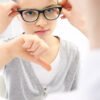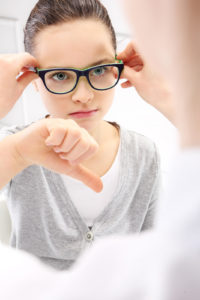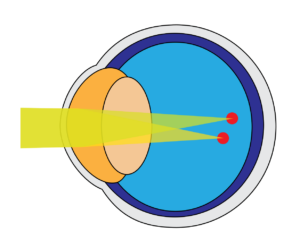
Treating Myopia in Children: The Pros and Cons of Orthokeratology
The obvious question today is this: what the heck is orthokeratology?
The short answer: orthokeratology (or Ortho-k) is a cutting-edge treatment for nearsighted children. We’ll unpack that moving forward, but here’s the basic gist. Ortho-k treatments involve using specially designed overnight contacts to correct myopia, or nearsightedness. As with any such treatment, there’s plenty to like and plenty to worry about. Time will tell if we’re looking at a valid therapy or a dead end, but there’s lots to discuss about it in the meantime. See what we dug up – both good and bad – on this emerging treatment.
The Problem
Myopia, more commonly known as nearsightedness, has become a growing problem for children. Incidence has reached an all-time high for Americans of all ages. But, the rates seen in children have been worrying enough for some to term the surge an “epidemic.” The US is relatively healthy compared to some countries. Studies have found that as many as 76 percent of Taiwanese twelve-year-old children can be considered myopic, a rate nearly four times higher than that seen in 1983. Clearly, this is a major problem that needs to be addressed.
The cause of this myopia epidemic is a little murky, but many experts have been pointing to the increasingly indoor existence that many kids lead. While that’s one way of saying “becoming glued to their iPads,” it’s a little more literal than you might think. Screen time is believed to factor into myopia, but there seems to be a much stronger correlation between the disorder and the amount of time a child spends indoors. The reason why is, again, a little unclear. The strongest case seems to lie in exposure to natural light. That’s why it’s so important to ensure your children spend enough time playing outside.
Whatever the reason for the increase, it’s an alarming one. Not only is myopia increasingly common, but it’s also a surprisingly serious disorder. Nearsightedness is the most well-known symptom, but myopic individuals are also at greater risk for more serious developments, such as retinal detachment or glaucoma. It’s relatively simple to treat nearsightedness with glasses, contacts, and eye vitamins. But, it’s awfully difficult to recover from some of the other dangers.
Treatment Options
 Myopia has a couple of different causes, the most common being axial myopia. In axial myopia, the eye is physically longer than it should be. That physical difference leads to difficulty properly focusing on far-field objects. However, there is a corresponding boost in a myopic person’s ability to focus on near-field objects. The end result is nearsightedness. Objects at a distance will appear fuzzy and indistinct. As anyone who ever suffered through myopia as a child can tell you, it can make reading a whiteboard at school a legitimate trial.
Myopia has a couple of different causes, the most common being axial myopia. In axial myopia, the eye is physically longer than it should be. That physical difference leads to difficulty properly focusing on far-field objects. However, there is a corresponding boost in a myopic person’s ability to focus on near-field objects. The end result is nearsightedness. Objects at a distance will appear fuzzy and indistinct. As anyone who ever suffered through myopia as a child can tell you, it can make reading a whiteboard at school a legitimate trial.
Corrective lenses can clear the problem up quickly, as can surgery, but both come with their own problems. Corrective lenses can be difficult to keep track of, especially for younger users with glasses. Contacts are a little friendlier to active lifestyles, but they also increase the risk of serious issues such as corneal ulcers or infection.
Surgery is an invasive procedure that shouldn’t be undertaken lightly, especially when we’re talking about younger patients. Both procedures have a further drawback in that they don’t do much to prevent future changes in sight. Lenses will often require replacements as an individual’s vision worsens or (more rarely) improves. Surgery is even less flexible.
Orthokeratology: A New Solution
Ortho-k may provide a different solution. Still, the heart of orthokeratology should be familiar. The therapy relies on special, purpose-designed contact lenses to physically reshape the eye. We’ve known for a long time that eyes can reshape under contacts. But, it was only recently that technology was developed that allowed us to take advantage of the phenomenon.
The lenses used work by inhibiting or encouraging the growth of cells in the eye. If the lens is in close proximity to the eye, growth is inhibited. If it’s in greater proximity to the eye, then growth is encouraged. As a result, it’s possible to use a lens as a “mold” for a growing eye. If begun early enough, ortho-k can work to reduce the characteristic lengthening seen in myopic eyes. Thus, correcting focus and hopefully restoring normal vision.
It’s a relatively simple solution, albeit one with complex technological underpinnings. And, that hypothetical promise has been – to some extent – realized in practice. Several long-term studies of ortho-k determined that the treatment did indeed have an appreciable effect on eye-growth. And, could in turn help mitigate the effects of myopia. As many supporters of the treatment point out, it should at least theoretically operate on into adulthood. Additionally, as the lenses used in ortho-k treatment are night-wear only, they’re actually less intrusive than active-wear contacts.
Concerns About the Treatment
No matter how good a new treatment looks, it’s important to come at it with a certain degree of skepticism. And ortho-k has its fair share of skeptics. Most concerns focus on the age of patients receiving ortho-k treatments. Ortho-k practitioners generally try to start treatment as early as they can for a couple of solid reasons.
First, cell growth is greater the younger a patient is, which can help boost the efficacy of the lenses. Second, myopia becomes more and more physically pronounced as children age. Starting early engages the problem before it becomes more serious and difficult to treat. However, the youth of those patients can exacerbate some of the issues seen with any contact lenses. Younger patients are more likely to neglect proper cleaning of their lenses, something that has already resulted in serious infections in North American ortho-k patients.
While the studies performed thus far have been positive, they don’t necessarily support certain claims of orthokeratology proponents, one of which is being able to semi-permanently improve a child’s vision isn’t enough.
Parents of children with myopia need to weigh the pros and cons of this fascinating treatment. If you can manage the upkeep and hygiene of ortho-k lenses, it could be life-changing for your child. Always discuss your options with your child’s eye doctor and consider getting multiple opinions.
Our Rebuild Your Vision Ocu-Plus Formula Contains All 17 Vitamins, Minerals, and Herbal Supplements to Improve Your Eye Health!












Leave Your Reply